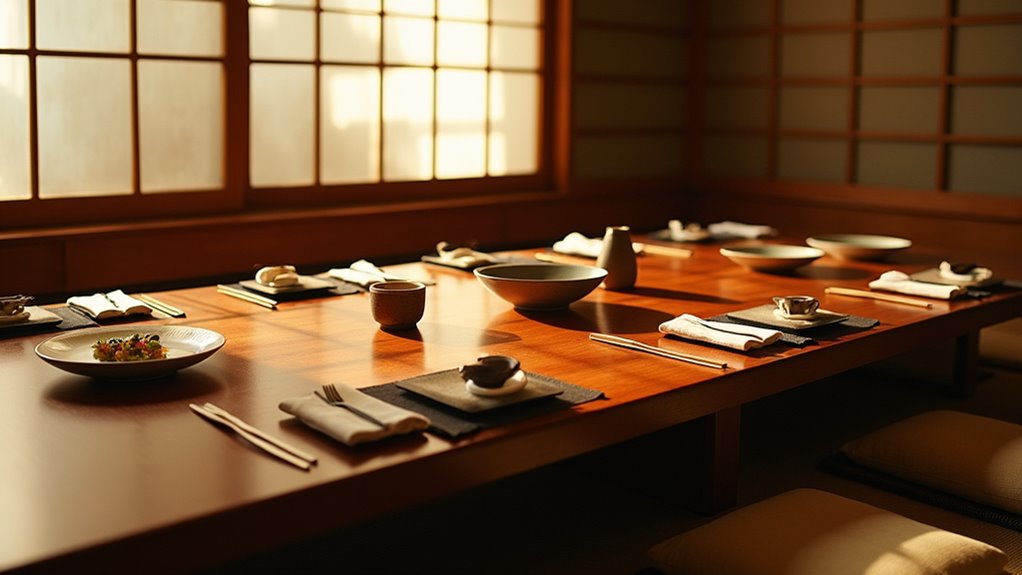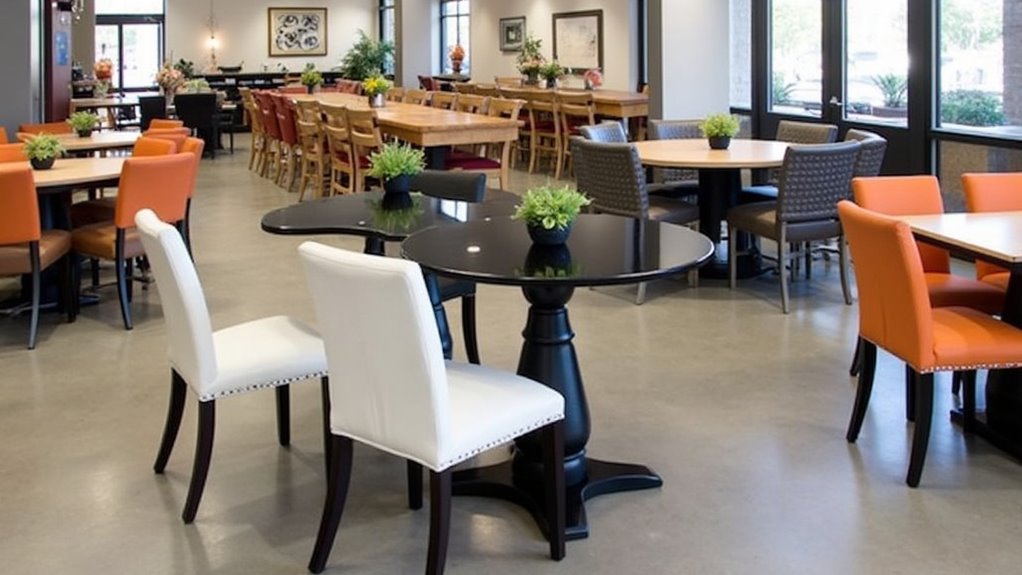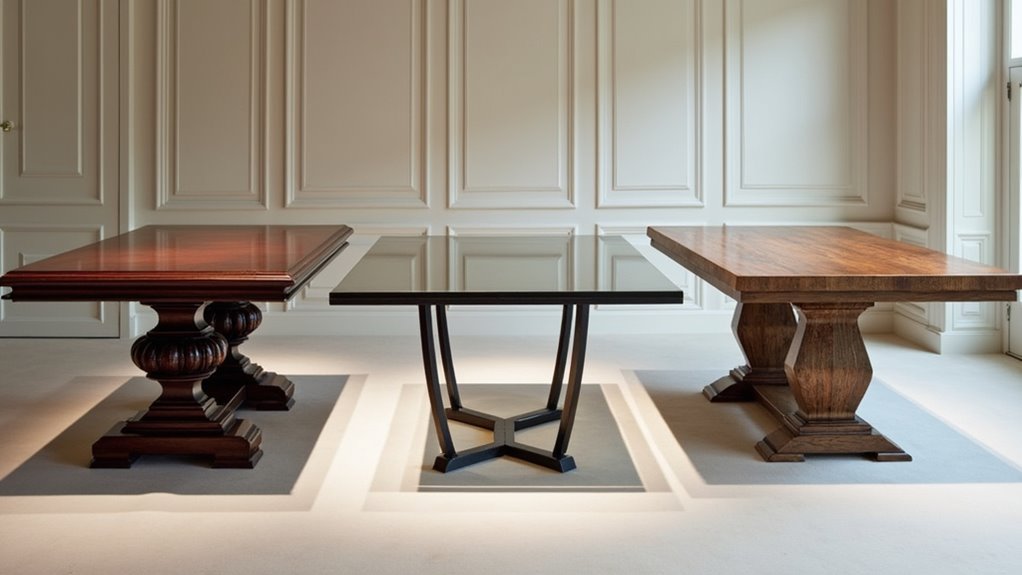Japanese dining tables are primarily referred to as chabudai and kotatsu, among others. Chabudai features short legs, fostering intimacy in family gatherings. On colder days, the kotatsu provides warmth with its heated design. Other variations include zen tables for individual meals and horigotatsu, which combines chair and floor seating. The arrangement and function of these tables reflect cultural values, offering insight into Japanese dining practices. Exploring further reveals more about their significance and modern adaptations.
Key Takeaways
- Japanese dining tables include types such as Chabudai, Kotatsu, Zen, and Horigotatsu, each serving different cultural and functional purposes.
- Chabudai features short legs, encouraging communal dining and floor seating during family meals.
- Kotatsu incorporates a heating element, providing warmth and comfort, especially in winter gatherings.
- Zen tables are individual tray tables, allowing for personal dining space and flexibility.
- Horigotatsu combines characteristics of traditional tables with recessed designs for comfortable legroom and chair-like seating.
Types of Traditional Japanese Dining Tables
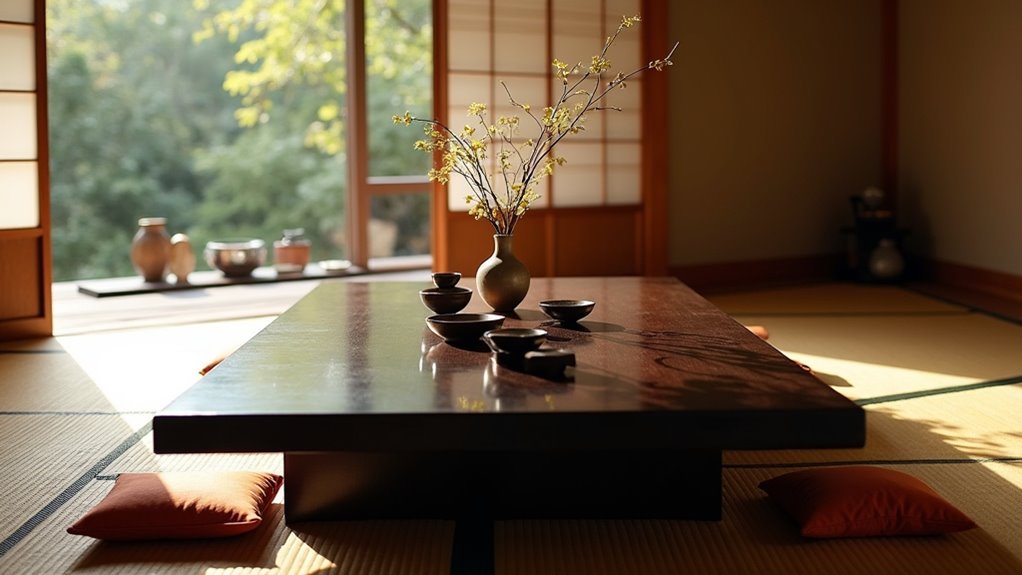
Traditional Japanese dining tables reflect a deep cultural significance, serving as the centerpiece for communal meals and social interaction.
The chabudai, characterized by its short legs and versatility, ranges from 15 to 30 cm in height, facilitating family gatherings around shared dishes. Its collapsible design promotes portability and easy storage, further emphasizing its role in fostering conversation during meals. Chabudai’s collapsible legs allow for easy movement and storage when not in use. This table design embodies the low-lying culture that encourages floor seating, enhancing the communal experience.
The chabudai embodies versatility and warmth, uniting families around shared meals with its collapsible design and inviting height.
Meanwhile, the kotatsu enriches the dining experience, particularly in winter, by incorporating a heating element beneath a futon-covered table. This multifunctional table not only provides warmth but also creates a cozy atmosphere, merging comfort with culinary enjoyment.
Together, these table types exemplify the balance of tradition and innovation in Japanese dining culture, reflecting social bonds through communal practices.
Seating Arrangements Around Japanese Tables
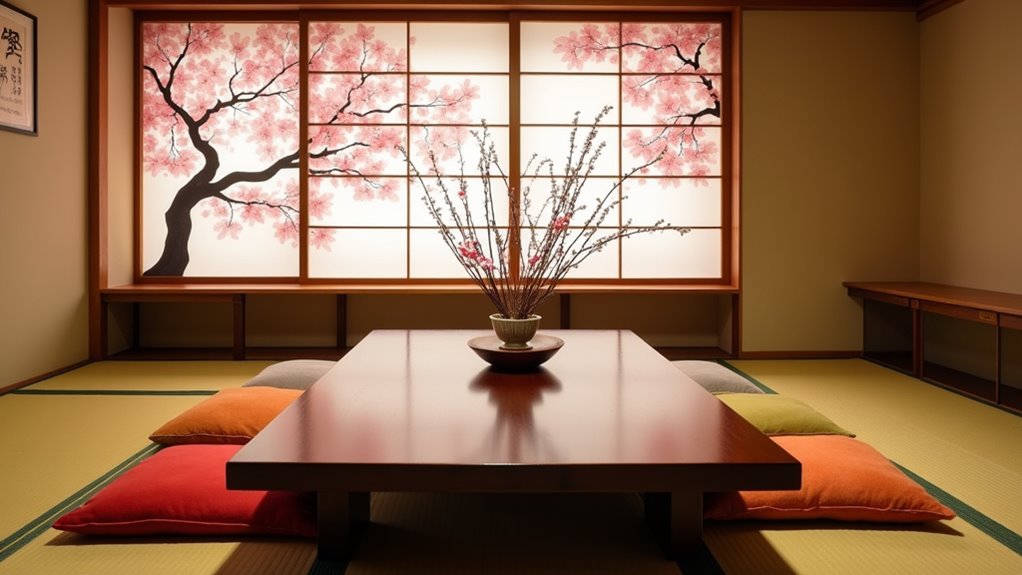
Seating arrangements around Japanese tables are meticulously structured, revealing a blend of cultural values and social dynamics that govern interactions during meals.
The organization of seating reflects a deep-rooted respect for hierarchy and tatami etiquette. Key aspects include:
- Senior individuals enjoy seats away from the entrance, promoting privacy.
- Guests of honor are positioned opposite doors, signifying respect.
- Junior members occupy seats closer to the entrance, acknowledging their status.
- Considerations for seating arrangements also emphasize convenience, minimizing interruptions during conversations.
Thus, whether at a traditional chabudai or a horigotatsu, the arrangement invites diners to appreciate the nuances of respect, tradition, and social harmony inherent in Japanese dining experiences.
Cultural and Functional Aspects of Japanese Dining Tables
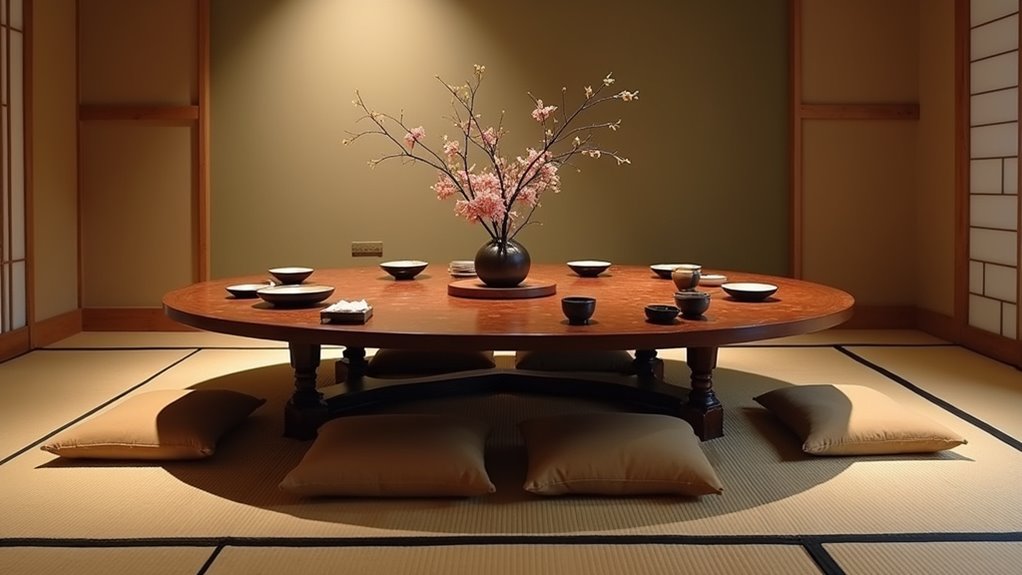
While dining tables in Japan serve essential functional purposes, they also embody profound cultural significance that reflects the values and customs of Japanese society.
These tables are not merely for sustaining physical nourishment; they engage deeply with ritual significance, emphasizing respect and gratitude. This ritualistic aspect is seamlessly intertwined with aesthetic considerations, where the thoughtful arrangement of dishes on the table symbolizes harmony, seasonality, and appreciation.
The design of tables reflects social hierarchy, promoting mindfulness and decorum during meals. Traditional forms, such as low tables, maintain a connection to heritage, serving as cultural touchpoints.
As visual representations of values, dining tables in Japan embody the fusion of utility and artistry, sustaining generational customs within domestic and social realms.
Specific Names and Functions of Table Types
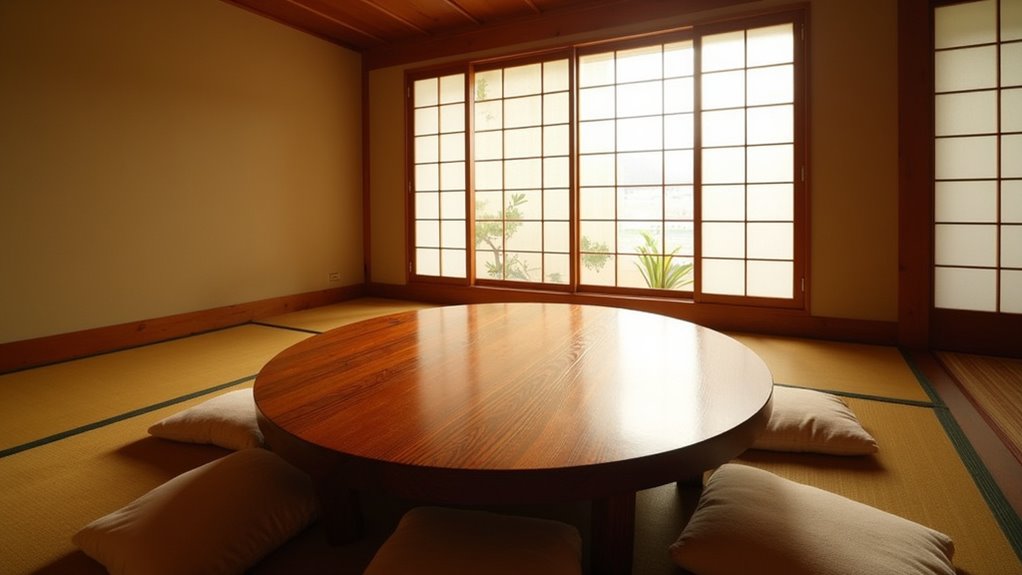
Japanese dining culture is defined by a variety of distinct table types, each serving specific purposes and reflecting the lifestyle of its users. The table types highlight unique dining styles and practices:
- Chabudai: A traditional low table inviting communal meals on cushions, central to family interaction.
- Kotatsu: A heated version of the chabudai, ensuring warmth during winter gatherings, blending comfort with tradition.
- Zen: Individual tray tables that promote personal space, allowing dining flexibility away from communal settings.
- Horigotatsu: A recessed table design accommodating legroom, offering the comfort of chair seating while preserving traditional floor dining.
These table types exemplify how Japanese dining styles prioritize both functionality and cultural significance in daily life.
Modern Usage and Contemporary Variations
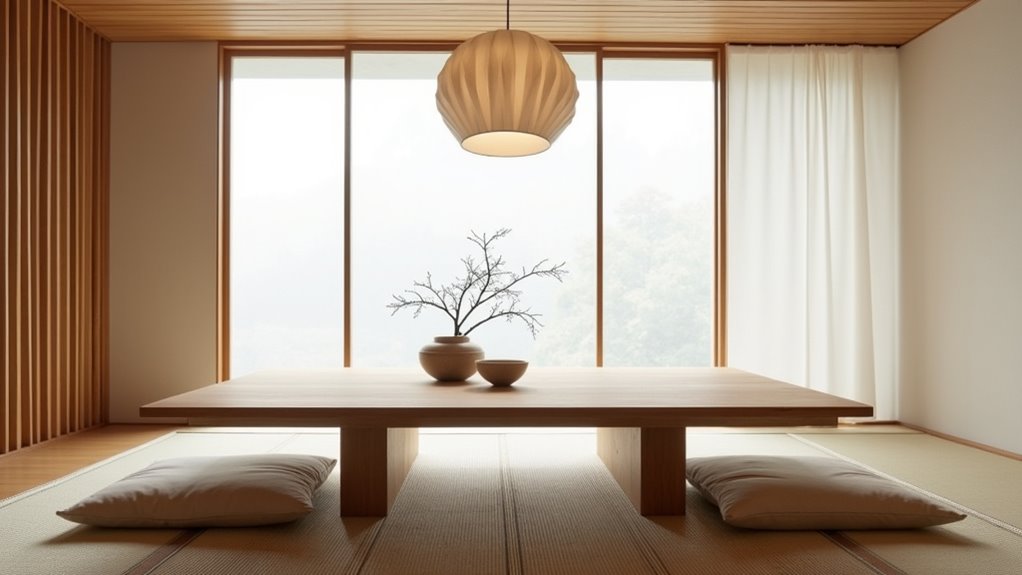
The evolution of dining tables in Japan reflects not only cultural traditions but also modern lifestyle adaptations that prioritize comfort and functionality.
Contemporary Japanese dining spaces exhibit low-profile furniture that fosters intimacy, aligning with traditional practices while embracing minimalist styles. Low wooden tables, complemented by ergonomically designed floor cushions, enhance dining aesthetics and promote communal experiences.
Influenced by the Japandi style, modern designs often feature clean lines and natural materials, resonating with eco-friendly values. Textures such as visible wood grains and organic textiles deepen the connection to nature.
Additionally, practical enhancements, including modular furniture and integrated heating elements, cater to urban living needs, ensuring comfort while maintaining the serene and simple ambiance inherent in Japanese culture.
Articles on the same topic:
-
Top 10 Dining Tables in Dubai for All Styles
-
7 Best Commercial Dining Tables and Chairs for Your Business
-
Top 3 Best Selling Dining Tables for 2025
-
Top 3 Brown Jordan Dining Tables for Your Outdoor Area
-
Top 3 Lexington Furniture Dining Tables for Your Home
-
7 Stunning Rustic Log Dining Room Tables for Your Home

